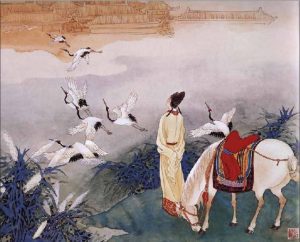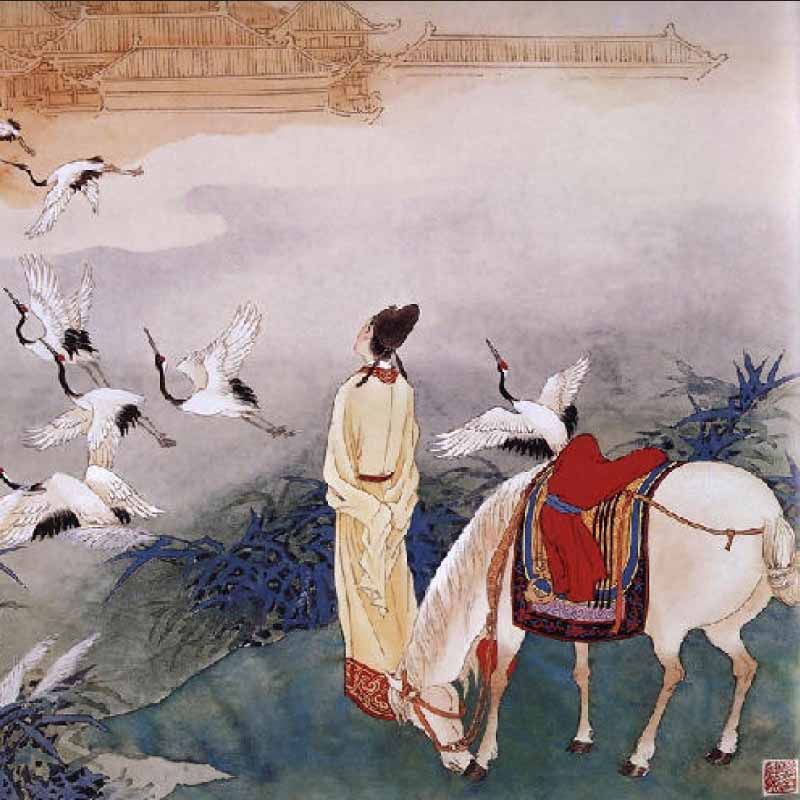
In the year 1027 BC, King Wu of Zhou and his younger brother Jidan overthrew the Shang Dynasty (1600-1046 BC) by enlisting the help of the slaves and established the Zhou Dynasty (1046-256 BC).
In order to consolidate the new state power, King Wu suppressed the rebellious tribes with the aid of Jidan, proclaiming himself “Son of Heaven” and supreme ruler of the country and its subjects. He then granted what land that did not belong to the state to the various feudal princes, on condition that they obey absolutely all his orders.
At the same time, the Son of Heaven initiated a system of collecting poems, in order to know what the people thought of him and to examine his own statesmanship.
Every spring and autumn, the Son of Heaven would assign and dispatch some officials to collect poems from the feudal states and have them set to music by court musicians before they were presented to him. In addition to this, officials of all ranks were also asked to present poems to the Son of Heaven, mainly to eulogize or to criticize him.
Later, the Son of Heaven gave orders to the musicians to sort out the more than 3,000 poems presented to him. Out of these was compiled an anthology of 305 poems which was given the title Poems or 300 Poems. This is the first comprehensive anthology of poems in China, which was renamed The Book of Songs (or Classic of Poetry) in the reign of Emperor Wu of the Han Dynasty (206 BC-220 AD).
Each poem in The Book of Songs was set to music and could be sung. Ancients classified the 305 poems into folk songs, ceremonial songs and sacrificial songs, according to their contents and the style of the music.
Folk songs, which were popular among the people, made up the best part of The Book of Songs, while ceremonial songs and sacrificial songs were used mainly on sacrificial or ceremonial occasions to eulogize the merits and virtues of the Son of Heaven and of his forefathers.
The contents of The Book of Songs reflect, with its wide variety, the political, economic, military and cultural life of ancient China during the 500 years or so from the early years of the Western Zhou Dynasty (1046–771 BC) to the middle part of the Spring and Autumn Period (770-476). It reveals the lives and the feelings of the people at that time.
Some of the poems describe productive labor, some express sentiments against exploitation and oppression, and some denounce wars. There are poems about love, marriage and family life. There are songs for feasting ceremonies, and there are accounts of historic events in the Zhou Dynasty. It can be said that The Book of Songs is a veritable mirror of society in the Zhou Dynasty.
The artistic quality of The Book of Songs is enhanced by the use of narration, analogy and association.
The poem “July,” for example, is about the weather of the four seasons, about the work of a peasant – tilling in spring, harvesting in autumn and hunting and building in winter.
It describes the work of a peasant woman – picking mulberry leaves, raising silkworms, dyeing and weaving and cutting and sewing. It depicts the day-to-day life of the peasants and the banquets of the nobles at year’s end.
Through a step-by-step description of the activities of each month in a year, the poems reveal the social reality of exploitation of peasants by the aristocracy.
Analogy is frequently employed in The Book of Songs. For example, to compare a beauty to white, spotless jade; an exploiter to a rat; or to use a line such as “a single day’s absence is like a separation of three long years” to show the deep longing two lovers feel for each other.
The first poem in The Book of Songs, “The Quacking Osprey,” is about a poet who, happening on an osprey quacking at the riverside for its mate, recalls the beautiful girl he is courting, and describes in the poem the painful, sleepless nights he spends turning and tossing in bed and imaginary scenes of lovemaking and finally marriage with his sweetheart. In the first two lines of the poem, “The quacking osprey, at the side of the river,” is seen as resorting to association.
Folk songs, ceremonial songs and sacrificial songs, narration, analogy and association constitute, as the ancients put it, the six quintessential elements in The Book of Songs. They also represent its main characteristics in terms of content and form.
Confucius was very fond of The Book of Songs. He used to recite the poems from time to time, and used it as a textbook for his pupils. Besides lecturing in his old age in the State of Lu after touring the other states, Confucius also edited the music of The Book of Songs.
In the Han Dynasty, The Book of Songs was formally accepted as a classic of the Confucian school.
The Book of Songs has over a long period of time been highly appreciated and has exerted a profound and far-reaching influence on the development of Chinese literature, especially that of poetry, over a period of more than 2,000 years. It has also served as important historical data for the study of ancient China from the early years of the Western Zhou Dynasty to the Spring and Autumn Period.
春秋《詩經》
公元前1027年,周武王和他弟弟姬旦一起利用廣大奴隸的力量,滅亡了商朝,建立了周朝。
周武王為了鞏固剛取得的政權,在姬旦的幫助下,先平定了叛亂的部族,然後自稱“天子”,是土地和臣民的最高統治者。
他把除了天子所有的公田以外的土地,全部分封給各個諸侯國,要他們絶對聽從天子的命令。同時,周天子為了了解人民對自己有什麽意見,考察自己的政治功績,建立了采詩制度。
每年的春天和秋天,周天子都要派出專門的官員到各諸侯國去採集詩歌。再由王宫的樂師把採來的詩歌配上樂曲獻給天子。
另外,各級官員也向天子獻詩,主要是讚美或者批評天子的詩歌。
後來,天子命令樂師把獻上的三千多首詩歌加以整理,從中選出了三百零五首,編成一部詩歌集子,稱作《詩》或
《詩三百》。到漢武帝時,改稱為《詩經》。這就是中國的第一部詩歌總集。
《詩經》中每一首詩都配上了樂曲,可以歌唱。古人根據三百零五篇詩歌的内容和樂曲的風格,分成鳳、雅、頌三部分。“鳳”大部分是民歌,流傳最廣,是《詩經》中的精華;“雅”、“頌”主要是讚美周天子及其祖先功德的詩歌,是在祭祀和宴會時使用的樂歌。
《詩經》的内容非常豐富,反映了西周初年到春秋中期大約五百年之間的政治、經濟、軍事、文化等各方面的情況,表現了人民的生活面貌和思想感情。這些詩歌,有寫勞動生產的,有反對剝削和壓迫的,有反對戰爭的,有寫戀愛、婚姻和家庭生活的,有祭祀和宴會時唱的,有寫周朝歴史的等等。可以說《詩經》是周朝社會的一面鏡子。
《詩經》採用了“賦”(鋪叙)、“比”(比喻)和“興”(起興)的手法,加强了詩歌的藝術性。例如《七月》這首詩,寫一年四季的氣候;寫農夫的勞動:春耕、秋收、冬獵、蓋房;寫農婦的勞動:採桑、養蚕、染織、製衣;寫農民們衣食住行和貴族們年終宴會的情景。採用“賦”的手法,層層鋪叙十二個月的活動,反映了農民受貴族剝削的社會現實。
比喻的手法在《詩經》中運用得很多。例如:用潔白的玉比作美女,用大老鼠比作剝削者,用“一日不見如三秋”比喻戀人之間互相思念的感情。
《詩經》的第一首詩是《關雎》,寫的是:詩人看見雎鳩鳥“關關”地叫著,在河邊尋找自己的伴侣,聯想起自己追求的那位美麗的姑娘,就把自己夜晚思念姑娘、翻來覆去睡不着的痛苦心情,以及幻想同姑娘戀愛結婚的情景加以表達和描繪。詩歌開頭兩句“關關雎鳩,在河之洲”,用的就是起興的手法。“鳳”、“雅”、
“頌”、“賦”、“比”、“興”就是古人所說的《詩經》六義,也就是指《詩經》内容和形式上的特點。
孔子非常喜歡《詩經》,經常吟誦,並且把《詩經》作為教育學生的資料。孔子周遊各國,晚年回到魯國以後,除了講學以外,還整理了《詩經》的樂曲。到了漢朝,《詩經》被正式列為儒家的經典著作之一。
長期以來,《詩經》一直受到很高的評價。它對中國兩千多年來的文學發展,尤其是詩歌的發展,有著深遠的影響。《詩經》也是研究西周初年到春秋時代的重要歴史資料。
